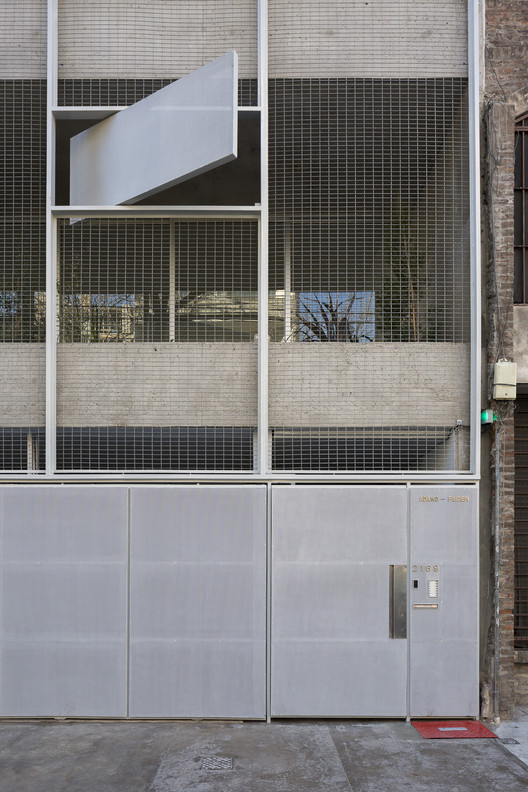University of Arizona Poetry Center Line and Space
2011-08-29 00:00
经过近50年的耐心寻找每一个新的诗歌出版,亚利桑那大学收集了一个最好的当代诗集在美国。随着藏书的掌握,该大学开始设计新家,这是一个存档、研究、阅读、教学和沉思的设施。亚利桑那大学的海伦·S·谢弗诗歌中心(Helen S.Schaefer)于2008年10月向公众以及作家、教师和学生开放。这座建筑创造了一个具有里程碑意义的设施,在那里可以完成提供杰出的研究收藏,很可能是美国当代诗歌最杰出的收藏,以及作家和诗歌读者的聚会场所的使命。
After nearly 50 years of patiently seeking out every new poetry publication, the University of Arizona amassed one of the finest collections of Contemporary Poetry in America. With collection in hand, the University set out to design its new home; a facility for archiving, research, reading, teaching, and contemplation. The University of Arizona's Helen S. Schaefer Poetry Center was opened to the public as well as writers, faculty and students in October 2008. The building creates a landmark facility where the mission of providing an outstanding research collection, quite possibly the most outstanding collection of contemporary poetry in America, and meeting place for writers and readers of poetry can be fulfilled.
在确定新设施的讨论过程中,很明显,建筑方案中存在着一些矛盾;希望提供一个适合积极讨论和安静独处的场所;在自然光下享受阅读的能力,同时提供保护,使其免受其破坏性的影响;与书籍的亲密关系以及大量存在着50 000卷被搁置的书籍的现实;当然,对安全的渴望,同时也使所有想要参与的人都能很容易地获得诗歌。这些矛盾与有价值的藏书与活跃的大学和社区资源相结合,推动了设计理念的形成。
During discussions defining the new facility, it became clear that there were a number of contradictions in the architectural program; the desire to provide a place suitable for active discourse as well as quiet solitude; the ability to enjoy reading in natural light while at the same time offering protection from its destructive nature; intimacy with the books and the reality of the massive presence of 50,000 shelved volumes; and, of course, the desire for security while at the same time making the poetry readily accessible to all who desired to partake. These contradictions inherent with combining a valuable collection with an active university and community resource drove the design concept.
在诗歌中心的设计中,读者和诗歌之间的联系是最重要的。这种联系在建筑物的规划中得到了改进,该计划被认为是“走向孤独的进程”。进步从西部开始,有一个活跃而嘈杂的人文研究室,它的透明墙壁可以被打开,允许在有阴影的过渡空间内的灵活性,并使大型活动的座位增加一倍。向东移动,公共功能在收藏品中溶入更亲密的空间-人们发现自己置身于竹园,一个独处和沉思的户外区域。
The connection between reader and poetry are overarching in the Poetry Center’s design. This connection is refined in the plan of the building which is conceived as a “progression towards solitude.” Progression starts at the west with an active and noisy Humanities Seminar Room whose transparent walls can be opened, allowing flexibility within the shaded transition space, and doubling the seating capacity for larger events. Moving east, public functions dissolve into more intimate spaces within the collection -- one finds themselves in the bamboo garden, an outdoor area of solitude and contemplation.
已采取措施,创造一个既吸引学术界又吸引公众的空间。有阴影的过渡空间欢迎游客来到大楼,同时用一系列屋顶飞机保护他们不受直接阳光的照射,这些屋顶飞机提供了从炎热的沙漠气候到凉爽的空调室内的过渡。“天洞”刺穿屋顶,进一步中介从明亮的外部到阴影的内部过渡。此外,一个隐藏式剧院,或小型表演剧院,位于这一过渡空间,并被设计成可全年提供阴凉的夏季和温暖的太阳在冬季。
Measures were taken to create a space that was inviting to both the academic community and the public. The shaded transition space welcomes visitors to the building while protecting them from direct sun with a series of roof planes that provide a transition from the hot desert climate to the cool air-conditioned interior. “Sky Holes” puncture the roof to further mediate the transition from the bright exterior to the shaded interior. Additionally, a recessed odeum, or small performance theater, is situated under this transition space, and is designed to be usable year-round providing shade in the summer and warming sun in the winter.
这座建筑是面向南面的,所以南面的窗户都是由悬挂物保护的,这样就可以在没有直接阳光的情况下进入空间。西面立面有最小的缝隙,提供了隐私和交通噪音的屏障,除了减少直接的太阳能热增益,这减少了对机械系统的需求。在东方,一堵“双面墙”遮住了建筑和竹园,同时庆祝理查德·谢尔顿的一首诗(“…”)中的一行。你应该学会沉默的艺术。“)用二进制代码打孔。
The building is oriented so that southern windows are protected by overhangs which allow daylight into the spaces with no direct sun. The west elevation has minimal fenestrations, providing privacy and a barrier from traffic noise, in addition to mitigating direct solar heat gain which reduces demand on the mechanical system. On the east, a “binary wall” shades the building and bamboo garden while celebrating a line from a Richard Shelton poem (“…you shall learn the art of silence.”) with holes punched out in binary code.
 举报
举报
别默默的看了,快登录帮我评论一下吧!:)
注册
登录
更多评论
相关文章
-

描边风设计中,最容易犯的8种问题分析
2018年走过了四分之一,LOGO设计趋势也清晰了LOGO设计
-

描边风设计中,最容易犯的8种问题分析
2018年走过了四分之一,LOGO设计趋势也清晰了LOGO设计
-

描边风设计中,最容易犯的8种问题分析
2018年走过了四分之一,LOGO设计趋势也清晰了LOGO设计




























































